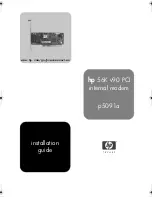
92
MINI-MODEM V.92
T
EST
P
ROCEDURE
1. Connect the modem to your computer. Using your communication program,
set the baud rate to 9600 and go into terminal mode.
2. Type AT&T1 and press ENTER. This places your modem in analog loopback
mode in the originate mode. A CONNECT message should appear on your
display. The modem is now out of command mode and in a pseudo-on-line
mode.
3. Note that the CD and TR indicators are on. If they are not on, there is a
defect in your modem.
4. Enter characters from your keyboard. For this test, typing multiple uppercase
U characters is a good way to send an alternating test pattern of binary ones
and zeros. The characters entered should be displayed on your monitor.
5. To exit the test, type the escape sequence +++AT and press ENTER. This puts
the modem in on-line command mode. Then type either AT&T or ATH to
return to command mode.
6. Your modem passes this test if the data received on your monitor are the same
as the data entered from your keyboard. If different data appear on your
monitor, your modem is probably causing the problem, though it could also
be your computer. If your modem passes this test, but you are receiving errors
while on-line, the remote modem or the phone line could be at fault.
A.2 Digital Loopback Test (V.54 Loop 2)
The remote digital loopback test tests the phone lines and the circuits of both your
local modem and a remote modem. In this test, your modem must be on-line with
another modem that is set up to respond to a request for remote digital loopback.
(Note that some modems might not support remote digital loopback or might
have it disabled.) Data from your computer or terminal is transmitted through
your modem and over the phone line to the remote modem, where it is then
looped back to your modem.














































